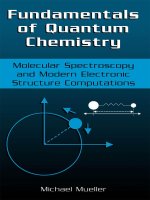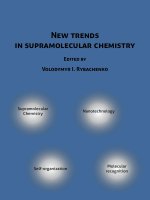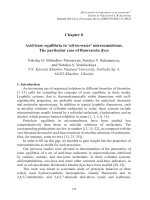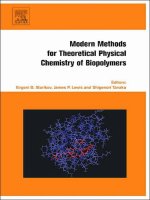Modern fluoroorganic chemistry
Bạn đang xem bản rút gọn của tài liệu. Xem và tải ngay bản đầy đủ của tài liệu tại đây (3.97 MB, 402 trang )
www.pdfgrip.com
Peer Kirsch
Modern Fluoroorganic Chemistry
www.pdfgrip.com
Related Titles
Wirth, T. (ed.)
Ojima, I. (ed.)
Organoselenium Chemistry
Synthesis and Reactions
Fluorine in Medicinal Chemistry
and Chemical Biology
2012
2009
ISBN: 978-3-527-32944-1
ISBN: 978-1-4051-6720-8
Petrov, V. A.
Mohr, F. (ed.)
Fluorinated Heterocyclic
Compounds
Gold Chemistry
Synthesis, Chemistry, and Applications
2009
ISBN: 978-0-470-45211-0
Applications and Future Directions in the
Life Sciences
2009
ISBN: 978-3-527-32086-8
www.pdfgrip.com
Peer Kirsch
Modern Fluoroorganic Chemistry
Synthesis, Reactivity, Applications
Second, Completely Revised and Enlarged Edition
www.pdfgrip.com
The Author
Prof. Dr. Peer Kirsch
Merck KGaA
Liquid Crystals R&D Chemistry
Frankfurter Str. 250
64293 Darmstadt
Germany
All books published by Wiley-VCH are
carefully produced. Nevertheless, authors,
editors, and publisher do not warrant the
information contained in these books,
including this book, to be free of errors.
Readers are advised to keep in mind that
statements, data, illustrations, procedural
details or other items may inadvertently be
inaccurate.
Library of Congress Card No.: applied for
British Library Cataloguing-in-Publication
Data
A catalogue record for this book is available
from the British Library.
Bibliographic information published by the
Deutsche Nationalbibliothek
The Deutsche Nationalbibliothek
lists this publication in the Deutsche
Nationalbibliografie; detailed bibliographic
data are available on the Internet at
<>.
© 2013 Wiley-VCH Verlag GmbH
& Co. KGaA, Boschstr. 12, 69469
Weinheim, Germany
All rights reserved (including those of
translation into other languages). No part
of this book may be reproduced in any
form – by photoprinting, microfilm, or any
other means – nor transmitted or translated
into a machine language without written
permission from the publishers. Registered
names, trademarks, etc. used in this book,
even when not specifically marked as such,
are not to be considered unprotected by law.
Print ISBN: 978-3-527-33166-6
ePDF ISBN: 978-3-527-65138-2
ePub ISBN: 978-3-527-65137-5
mobi ISBN: 978-3-527-65136-8
oBook ISBN: 978-3-527-65135-1
Cover Design Grafik-Design Schulz,
Fuògăonheim
Typesetting Laserwords Private Limited,
Chennai, India
Printing and Binding Markono Print
Media Pte Ltd, Singapore
Printed in Singapore
Printed on acid-free paper
www.pdfgrip.com
v
To Annette and Alexander
‘‘The fury of the chemical world is the element fluorine. It exists peacefully in the company
with calcium in fluorspar and also in a few other compounds; but when isolated, as it
recently has been, it is a rabid gas that nothing can resist.’’
Scientific American, April 1888.
‘‘Fluorine leaves nobody indifferent; it inflames emotions be that affections or aversions.
As a substituent, it is rarely boring, always good for a surprise, but often completely
unpredictable.’’
M. Schlosser, Angew. Chem. Int. Ed. 1998, 37, 1496–1513.
www.pdfgrip.com
www.pdfgrip.com
VII
Contents
Preface to the Second Edition XIII
Preface to the First Edition XV
Abbreviations XVII
1
1.1
1.2
1.3
1.3.1
1.3.2
1.4
1.4.1
1.4.2
1.4.3
1.4.3.1
1.4.3.2
1.4.4
1.4.5
Introduction 1
Why Organofluorine Chemistry? 1
History 1
The Basic Materials 3
Hydrofluoric Acid 3
Fluorine 5
The Unique Properties of Organofluorine Compounds 7
Physical Properties 7
Chemical Properties 13
Ecological Impact 15
Ozone Depletion by Chlorofluorocarbons 15
Greenhouse Effect 17
Physiological Properties 18
Analysis of Fluorochemicals: 19 F NMR Spectroscopy 20
References 21
Part I
2
2.1
2.2
2.3
2.3.1
2.3.2
2.3.3
2.3.4
2.3.5
Synthesis of Complex Organofluorine Compounds
Introduction of Fluorine 27
Perfluorination and Selective Direct Fluorination 27
Electrochemical Fluorination (ECF) 34
Nucleophilic Fluorination 36
Finkelstein Exchange 36
‘‘Naked’’ Fluoride 36
Lewis Acid-Assisted Fluorination 39
The ‘‘General Fluorine Effect’’ 41
Amine–Hydrogen Fluoride and Ether–Hydrogen Fluoride
Reagents 42
www.pdfgrip.com
25
VIII
Contents
2.3.6
2.4
2.4.1
2.4.2
2.4.3
2.4.4
2.4.5
2.4.6
2.4.7
2.4.8
2.4.9
2.4.10
2.4.10.1
2.4.11
2.5
2.5.1
2.5.1.1
2.5.1.2
2.5.1.3
2.5.1.4
2.5.2
2.5.2.1
2.5.3
2.5.4
2.6
2.6.1
2.6.2
2.6.3
3
3.1
3.1.1
3.1.2
3.1.3
3.2
3.2.1
3.2.2
3.2.3
3.3
3.3.1
3.3.2
3.3.3
Hydrofluorination, Halofluorination, and Epoxide Ring Opening 43
Synthesis and Reactivity of Fluoroaromatic Compounds 46
Synthesis of Fluoroaromatic Compounds 46
Reductive Aromatization 47
The Balz–Schiemann Reaction 47
The Fluoroformate Process 49
Transition Metal-Catalyzed Aromatic Fluorination 49
The Halex Process 55
Think Negative! – ‘‘Orthogonal’’ Reactivity of Perfluoroaromatic and
Perfluoroolefinic Systems 55
The ‘‘Special Fluorine Effect’’ 58
Aromatic Nucleophilic Substitution 59
Activation of the Carbon–Fluorine Bond by Transition Metals 63
Electrophilically Activated Arylation by Fluoroarenes 63
Activation of Fluoroaromatic Compounds by Ortho-Metalation 64
Transformations of Functional Groups 67
Hydroxy into Fluoro 67
Two-Step Activation–Fluorination 68
α, α-Difluoroalkylamine and α-Fluoroenamine Reagents 68
Sulfur Tetrafluoride, DAST, and Related Reagents 71
Amine–Hydrogen Fluoride Reagents 73
Conversion of Carbonyl into gem-Difluoromethylene 74
Sulfur Tetrafluoride, DAST, and Related Reagents 74
Carboxyl into Trifluoromethyl 77
Oxidative Fluorodesulfuration 78
‘‘Electrophilic’’ Fluorination 85
Xenon Difluoride 85
Perchloryl Fluoride and Hypofluorides 86
‘‘NF’’-Reagents 88
References 98
Perfluoroalkylation 107
Radical Perfluoroalkylation 107
Structure, Properties, and Reactivity of Perfluoroalkyl Radicals 107
Preparatively Useful Reactions of Perfluoroalkyl Radicals 110
‘‘Inverse’’ Radical Addition of Alkyl Radicals to Perfluoroolefins 115
Nucleophilic Perfluoroalkylation 118
Properties, Stability, and Reactivity of Fluorinated Carbanions 118
Perfluoroalkyl Metal Compounds 120
Perfluoroalkylsilanes 130
‘‘Electrophilic’’ Perfluoroalkylation 139
Properties and Stability of Fluorinated Carbocations 139
Arylperfluoroalkyliodonium Salts 142
Perfluoroalkyl Sulfonium, Selenonium, Telluronium, and Oxonium
Salts 149
www.pdfgrip.com
Contents
3.3.4
3.4
Fluorinated Johnson Reagents 156
Difluorocarbene and Fluorinated Cyclopropanes
References 160
4
4.1
4.2
4.3
Selected Fluorinated Structures and Reaction Types 169
Difluoromethylation and Halodifluoromethylation 169
The Perfluoroalkoxy Group 172
The Perfluoroalkylthio Group and Sulfur-Based
Super-Electron-Withdrawing Groups 176
The Pentafluorosulfanyl Group and Related Structures 179
References 188
4.4
5
5.1
5.2
156
The Chemistry of Highly Fluorinated Olefins 193
Fluorinated Polymethines 193
Fluorinated Enol Ethers as Synthetic Building Blocks
References 205
Part II
Fluorous Chemistry
207
6
6.1
Fluorous Chemistry 209
Fluorous Biphase Catalysis
References 224
7
7.1
7.2
7.3
Fluorous Synthesis and Combinatorial Chemistry 227
Fluorous Synthesis 227
Separation on Fluorous Stationary Phases 232
Fluorous Concepts in Combinatorial Chemistry 233
References 242
Part III
8
8.1
8.2
8.3
8.4
8.4.1
8.4.2
8.4.2.1
8.4.3
8.4.3.1
8.4.3.2
8.4.3.3
8.4.3.4
198
209
Applications of Organofluorine Compounds 245
Halofluorocarbons, Hydrofluorocarbons, and Related
Compounds 247
Polymers and Lubricants 249
Applications in the Electronics Industry 256
Fluorinated Dyes 258
Liquid Crystals for Active Matrix Liquid Crystal Displays 260
Calamitic Liquid Crystals: a Short Introduction 260
Functioning of Active Matrix LCDs 261
The Physical Properties of Nematic Liquid Crystals 264
Why Fluorinated Liquid Crystals? 267
Improved Mesophase Behavior by Lateral Fluorination 267
Fluorinated Polar Groups 269
Improved Reliability 274
Fluorinated Bridge Structures 275
www.pdfgrip.com
IX
X
Contents
8.4.4
8.5
8.5.1
8.5.2
Conclusion and Outlook 279
Fluorine in Organic Electronics 281
Organic Field Effect Transistors (OFETs) 281
Organic Light-Emitting Diodes (OLEDs) 290
References 293
9
9.1
9.2
9.3
9.4
9.5
9.6
9.7
9.8
9.9
9.10
9.11
9.12
Pharmaceuticals and Other Biomedical Applications 299
Why Fluorinated Pharmaceuticals? 299
Lipophilicity and Substituent Effects 300
Hydrogen Bonding and Electrostatic Interactions 303
Stereoelectronic Effects and Conformation 306
Metabolic Stabilization and Modulation of Reaction Centers
Bioisosteric Mimicking 316
Mechanism-Based ‘‘Suicide’’ Inhibition 325
Fluorinated Radiopharmaceuticals 329
Inhalation Anesthetics 333
Blood Substitutes and Respiratory Fluids 334
Contrast Media and Medical Diagnostics 335
Agricultural Chemistry 336
References 340
A.1
A.1.1
A.1.2
A.1.3
A.1.4
A.2
A.2.1
A.2.2
A.2.3
A.3
A.3.1
A.3.2
A.4
A.4.1
A.4.2
A.4.3
A.5
A.5.1
A.5.2
A.6
310
Appendix A: Typical Synthetic Procedures 351
Selective Direct Fluorination 351
General Remarks 351
Fluorination of Diethyl Malonate (1) to Diethyl Fluoromalonate
(2) 352
Synthesis of Bis(4-nitrophenyl)tetrafluorosulfurane (4) (Isomeric
Mixture: 15% trans–85% cis) 352
Isomerization to trans-4 353
Hydrofluorination and Halofluorination 353
General Remarks 353
Synthesis of the Liquid Crystal 6 354
Synthesis of 8 354
Electrophilic Fluorination with F-TEDA–BF4 (Selectfluor) 355
Synthesis of the Fluorosteroid 11 355
Synthesis of Diethyl Fluorophenylmalonate (13) 355
Fluorinations with DAST and BAST (Deoxofluor) 356
General Remarks 356
General Procedure for Fluorination of Alcohols 356
General Procedure for Fluorination of Aldehydes and Ketones 357
Fluorination of a Carboxylic Acid with Sulfur Tetrafluoride 358
General Remarks 358
Synthesis of 4-Bromo-2-(trifluoromethyl)thiazole (23) 358
Generation of a Trifluoromethoxy Group by Oxidative
Fluorodesulfuration of a Xanthogenate 358
www.pdfgrip.com
Contents
A.6.1
A.7
A.7.1
A.7.2
A.7.3
A.8
A.8.1
A.9
A.9.1
A.10
A.10.1
A.10.2
A.11
A.11.1
A.11.2
A.12
A.12.1
A.12.2
A.12.3
A.13
A.13.1
A.13.2
Synthesis of the Liquid Crystal 25 358
Oxidative Alkoxydifluorodesulfuration of Dithianylium Salts 359
Dithianylium Triflate (27) 359
Synthesis of 28 from the Dithianylium Salt 27 360
Synthesis of 28 from the Ketenedithioketal 29 360
Electrophilic Trifluoromethylation with Umemoto’s Reagents 361
Trifluoromethylation of the Trimethylsilyldienol Ether 30 361
Nucleophilic Trifluoromethylation with Me3 SiCF3 362
Nucleophilic Trifluoromethylation of Ketone 33 362
Transition Metal-Mediated Aromatic Perfluoroalkylation 362
Copper-Mediated Trifluoromethylation of 36 Using Silane
Reagents 362
Palladium-Mediated Trifluoromethylation of Aryl Chloride 41 363
Copper-Mediated Introduction of the Trifluoromethylthio Group 364
Preparation of Trifluoromethylthio Copper Reagent 43 364
Reaction of CuSCF3 with 4-Iodoanisole (44) 364
Substitution Reactions on Fluoroolefins and Fluoroarenes 365
Preparation of α, β-Difluoro-β-chlorostyrenes (47) 365
Preparation of α, β-Difluorocinnamic Acid (48) 365
ortho-Metalation of 1,2-Difluorobenzene (49) with LDA 365
Reactions with Difluoroenolates 366
Preparation of the Trimethylsilyl Difluoroenol Ether 52 366
Addition of 52 to Carbonyl Compounds 367
References 367
Appendix B: Index of Synthetic Conversions
Index
373
www.pdfgrip.com
369
XI
www.pdfgrip.com
XIII
Preface to the Second Edition
Within the few years since the first edition, the landscape of fluorine chemistry
has changed dramatically: it is no longer the domain of a highly specialized
(and often quite courageous) community, but the field has attracted the attention
of mainstream organic and bioorganic chemists. The value of fluorine substitution in bioactive compounds and other functional materials has been widely
recognized beyond the boundaries of the traditional fluorine chemistry community. Consequently, the variety of available synthetic methodology has exploded.
A review with a reasonable degree of completeness has become impossible,
and even the selection of the most significant developments is a very difficult
task.
The scope of this book is not to offer a complete review of available methods,
but to provide an introduction and a representative overview over the rapidly
evolving field for the interested newcomer. It should be used as an entry point
for a detailed in-depth study, but it is not intended as a stand-alone encyclopedia
of fluorine chemistry. Therefore, there are many omissions, and the selection of
the most interesting new developments has often been a matter of taste of the
author.
The focus of the second edition is application fields where fluorine is essential for
function, and also the chemistry needed to access such compounds. This applies
not only to the material sciences but of course also to the biomedical field. On
the synthetic side, the most remarkable new development is a huge variety of
transition metal-catalyzed methods for the introduction of fluorine and fluorinated
groups.
From the conceptual side, the author’s choice of the most important new
developments has been covered. From the application side, two new areas have
been added: fluorinated dyes as one of the first areas of the industrial application
of fluorine chemistry was recognized as a gap in the previous edition. In the last 10
years, the field of organic electronics has developed tremendously, and also here
fluorine chemistry has found a very specific range of applications. A short review
of the role and function of fluorine chemistry in this rapidly developing field has
been added.
The author would like to thank the friends and colleagues who have provided their help and valuable input during the update of the text. In particular,
www.pdfgrip.com
XIV
Preface to the Second Edition
Matthias Bremer, Alois Haas, Ingo Krossing, David OHagan, Gerd Răoschenthaler,
Georg Schulz, Peter and Marina Wanczek, John Welch, and Yurii Yagupolskii supported my project with information and critical discussions. From Wiley-VCH,
Anne Brennfăuhrer and Lesley Belt provided me with steady support and encouragement. Most of all, I owe my gratitude to my wife Annette and my son
Alexander, who received much less attention than they deserved and who provided
an environment where I could make the time for writing a book on top of many
other things.
Seeheim-Jugenheim
January 2013
Peer Kirsch
www.pdfgrip.com
XV
Preface to the First Edition
The field of fluoroorganic chemistry has grown tremendously in recent years, and
fluorochemicals have permeated nearly every aspect of our daily lives. This book
is aimed at the synthetic chemist who wants to gain a deeper understanding of
the fascinating implications of including the highly unusual element fluorine in
organic compounds.
The idea behind this book was to introduce the reader to a wide range of
synthetic methodology, based on the mechanistic background and the unique
chemical and physicochemical properties of fluoroorganic compounds. There
are quite some barriers to entering the field of preparative fluoroorganic chemistry, many based on unfounded prejudice. To reduce the threshold to practical
engagement in fluoroorganic chemistry, I include some representative synthetic procedures which can be performed with relatively standard laboratory
equipment.
To point out what can be achieved by introducing fluorine into organic molecules,
a whole section of this book is dedicated to selected applications. Naturally, because
of the extremely wide range of sometime highly specialized applications, this part
had to be limited to examples which have gained particular importance in recent
years. Of course, this selection is influenced strongly by the particular ‘‘taste’’ of
the author.
I could not have completed this book without help and support from friends
and colleagues. I would like to thank my colleagues at Merck KGaA, in particular
Detlef Pauluth for his continuous support of my book project, and Matthias
Bremer and Oliver Heppert for proof reading and for many good suggestions
and ideas how to improve the book. The remaining errors are entirely my fault.
G. K. Surya Prakash, Karl O. Christe, and David O’Hagan not only gave valuable
advice but also provided me with literature. Gerd-Volker Răoschenthaler, Găunter
Haufe, and Max Lieb introduced me to the fascinating field of fluorine chemistry.
Andrew E. Feiring and Barbara Hall helped me to obtain historical photographs.
Elke Maase from Wiley-VCH accompanied my work with continuous support and
encouragement.
www.pdfgrip.com
XVI
Preface to the First Edition
In the last 18 months I have spent most of my free time working on this book
and not with my family. I would, therefore, like to dedicate this book to my wife
Annette and my son Alexander.
Darmstadt
May 2004
Peer Kirsch
www.pdfgrip.com
XVII
Abbreviations
acac
aHF
AIBN
AM
ASV
ATPH
Acetylacetonate ligand
Anhydrous hydrofluoric acid
Azobis(isobutyronitrile)
Active matrix
‘‘Advanced super-V’’
Aluminum tri[2,6-bis(tert-butyl)phenoxide]
BAST
BINOL
Boc
Bop-Cl
BSSE
BTF
N,N-Bis(methoxyethyl)amino sulfur trifluoride
1,1 -Bi-2-naphthol
tert-Butoxycarbonyl protecting group
Bis(2-oxo-3-oxazolidinyl)phosphinic chloride
Basis set superposition error
Benzotrifluoride
CFC
COD
CSA
Cso
CVD
cVHP
Chlorofluorocarbon
Cyclooctadiene
Camphorsulfonic acid
Camphorsulfonyl protecting group
Chemical vapor deposition
Chicken villin headpiece subdomain
DABCO
DAM
DAST
DBH
DBPO
DEAD
DCC
DCEH
DEC
DFI
DFT
DIP-Cl
DMAc
DMAP
DME
DMF
DMS
DMSO
DSM
Diazabicyclooctane
Di(p-anisyl)methyl protecting group
N,N-Diethylamino sulfur trifluoride
1,3-Dibromo-5,5-dimethylhydantoin
Dibenzoyl peroxide
Diethyl azodicarboxylate
Dicyclohexylcarbodiimide
Dicarboxyethoxyhydrazine
N,N-Diethylcarbamoyl protecting group
2,2-Difluoro-1,3-dimethylimidazolidine
Density functional theory
β-Chlorodiisopinocampheylborane
N,N-Dimethylacetamide
4-(N,N-Dimethylamino)pyridine
1,2-Dimethoxyethane
N,N-Dimethylformamide
Dimethyl sulfide
Dimethyl sulfoxide
Dynamic scattering mode
www.pdfgrip.com
XVIII
Abbreviations
DTBP
dTMP
dUMP
Di-tert-butyl peroxide
Deoxythymidine monophosphate
Deoxyuridine monophosphate
ECF
ED
EPSP
ETFE
Electrochemical fluorination
Effective dose
5-Enolpyruvylshikimate-3-phosphate
Poly(ethylene-co-tetrafluoroethylene)
FAR
FDA
FDG
FET
FFS
FITS
FRPSG
FSPE
F-TEDA
α-Fluorinated alkylamine reagents
Fluorodeoxyadenosine
Fluorodeoxyglucose
Field effect transistor
Fringe field switching
Perfluoroalkyl phenyl iodonium trifluoromethylsulfonate reagents
Fluorous reversed-phase silica gel
Fluorous solid-phase extraction
N-Fluoro-N -chloromethyldiazoniabicyclooctane reagents
GWP
Global warming potential
HFCF
HFC
HFP
HMG+
HMPA
HSAB
Hydrofluorocarbon
Hydrofluorocarbon
Hexafluoropropene
Hexamethylguanidinium cation
Hexamethylphosphoric acid triamide
Hard and soft acids and bases (Pearson concept)
IPS
ITO
In-plane switching
Indium tin oxide
LC
LCD
LD
LDA
1. Liquid crystal
2. Lethal concentration
Liquid crystal display
Lethal dose
Lithium diisopropylamide
MCPBA
MEM
MOM
MOST
MVA
m-Chloroperbenzoic acid
Methoxyethoxymethyl protecting group
Methoxymethyl protecting group
Morpholino sulfur trifluoride
Multi-domain vertical alignment
NAD+ /NADH
NADP+ /NADPH
NBS
NCS
NE
NFPy
NFTh
NIS
NLO
NMP
NPSP
Nicotinamide adenine dinucleotide, oxidized/reduced form
Nicotinamide adenine dinucleotide phosphate, oxidized/reduced form
N-Bromosuccinimide
N-Chlorosuccinimide
Norepinephrine
N-Fluoropyridinium tetrafluoroborate
N-Fluoro-o-benzenedisulfonimide
N-Iodosuccinimide
Nonlinear optics
N-Methylpyrrolidone
N-Phenylselenylphthalimide
www.pdfgrip.com
Abbreviations
OD
ODP
OFET
OLED
OPV
OTFT
Ornithine decarboxylase
Ozone-depleting potential
Organic field effect transistor
Organic light-emitting diode
Organic photovoltaics
Organic thin-film transistor
PCH
PCTFE
PDA
PET
PFA
PFC
PFMC
PFOA
PFOB
PFOS
phen
PI
PIDA
pip+
PLP
PNP
PPVE
PTC
PTFE
PVDF
PVPHF
P3DT
Phenylcyclohexane
Polychlorotrifluoroethylene
Personal digital assistant
1. Positron emission tomography
2. Poly(ethylene terephthlate)
Perfluoropolyether
Perfluorocarbon
Perfluoro(methylcyclohexane)
Perfluorooctanoic acid
Perfluoro-n-octyl bromide
Perfluorooctylsulfonic acid
Phenanthroline
Polyimide
Phenyliodonium diacetate
1,1,2,2,6,6-Hexamethylpiperidinium cation
Pyridoxal phosphate
Purine nucleoside phosphorylase
Poly(heptafluoropropyl trifluorovinyl ether)
Phase transfer catalysis
Polytetrafluoroethylene (TeflonTM )
Poly(vinylidene difluoride)
Poly(vinylpyridine) hydrofluoride
Poly(3-dodecylthiophene)
QM/MM
QSAR
Quantum mechanics/molecular mechanics
Quantitative structure–activity relationships
SAH
SAM
S-Adenosylhomocysteine hydrolase
1. S-Adenosylmethionine
2. Self-assembled monolayer
Sodium bis(methoxyethoxy)aluminum hydride
Supercritical carbon dioxide
Supercritical fluid chromatography
Single electrton transfer
Superfluorinated material
Solid-phase extraction
Super-twisted nematic
SBAH
scCO2
SFC
SET
SFM
SPE
STN
TADDOL
TAS+
TASF
TBAF
TBDMS
TBS
α,α,α ,α -Tetraaryl-2,2-dimethyl-1,3-dioxolane-4,5-dimethanol
Tris(dimethylamino)sulfonium cation
Tris(dimethylamino)sulfonium difluorotrimethylsiliconate, (Me2 N)3 S+
Me3 SiF2 −
Tetrabutylammonium fluoride
tert-Butyldimethylsilyl protecting group
See TBDMS
www.pdfgrip.com
XIX
XX
Abbreviations
TBTU
TDAE
TEMPO
TFT
THF
THP
TIPS
TLC
TMS
TN
TPP
TPPO
TR
O-(Benzotriazol-1-yl)-N,N,N ,N -tetramethyluronium tetrafluoroborate
Tetrakis(dimethylamino)ethylene
2,2,6,6-Tetramethylpiperidine-N-oxide
Thin film transistor
1. Tetrahydrofuran
2. Tetrahydrofolate coenzyme
Tetrahydropyranyl protecting group
Triisopropylsilyl protecting group
Thin-layer chromatography
Trimethylsilyl protecting group
Twisted nematic
Triphenylphosphine
Triphenylphosphine oxide
Trypanothione reductase
VHR
Voltage holding ratio
ZPE
Zero point energy
www.pdfgrip.com
1
1
Introduction
1.1
Why Organofluorine Chemistry?
Fluorine is the element of extremes, and many fluorinated organic compounds
exhibit extreme and sometimes even bizarre behavior. A large number of polymers,
liquid crystals, and other advanced materials owe their unique property profile to
the influence of fluorinated structures.
Fluoroorganic compounds are almost completely foreign to the biosphere.
No central biological processes rely on fluorinated metabolites. Many modern
pharmaceuticals and agrochemicals, on the other hand, contain at least one fluorine
atom, which usually has a very specific function. Perfluoroalkanes, especially, can
be regarded as ‘‘orthogonal’’ to life – they can assume a purely physical function,
for example, oxygen transport, but are foreign to the living system to such an extent
that they are not recognized and are completely ignored by the body.
Although fluorine itself is the most reactive of all elements, some fluoroorganic
compounds have chemical inertness like that of the noble gases. They sometimes
cause ecological problems not because of their reactivity but because of the lack of
it, making them persistent in Nature on a geological time scale.
All these points render fluoroorganic chemistry a highly unusual and fascinating
field [1–14], providing surprises and intellectual stimulation in the whole range
of chemistry-related sciences, including theoretical, synthetic, and biomedical
chemistry and materials science.
1.2
History
Because of the hazardous character of hydrofluoric acid and the difficult access
to elemental fluorine itself, the development of organofluorine chemistry and the
practical use of fluoroorganic compounds started relatively late in the nineteenth
century (Table 1.1). The real breakthrough was the first synthesis of elemental fluorine by Henri Moissan in 1886 [15], but the first defined fluoroorganic compound,
Modern Fluoroorganic Chemistry: Synthesis, Reactivity, Applications, Second Edition. Peer Kirsch.
© 2013 Wiley-VCH Verlag GmbH & Co. KGaA. Published 2013 by Wiley-VCH Verlag GmbH & Co. KGaA.
www.pdfgrip.com
2
1 Introduction
Table 1.1
Dates and historical key events in the development of fluoroorganic chemistry.
Time
Key event
1764
First synthesis of hydrofluoric acid from fluorspar and sulfuric acid by
A. S. Marggraf, repeated in 1771 by C. Scheele
Synthesis of benzoyl fluoride as the first fluoroorganic compound by
A. Borodin
First synthesis of elemental fluorine by H. Moissan (Nobel Prize in 1906) by
electrolysis of an HF–KF system
Beginning of halofluorocarbon chemistry by direct fluorination (H. Moissan)
and Lewis acid-catalyzed halogen exchange (F. Swarts)
Access to fluoroarenes by the Balz–Schiemann reaction
Refrigerants (Freon, in Germany Frigen), fire extinguishing chemicals
(Halon), aerosol propellants. Fluorinated dyes with enhanced color fastness.
Polymers (PTFE = Teflon), electrochemical fluorination (H. Simons)
Manhattan Project: highly resistant materials for isotope separation plants,
lubricants for gas centrifuges, and coolants
Fluoropharmaceuticals, agrochemicals, artificial blood substitutes, respiratory
fluids, and chemical weapons
Gases for plasma etching processes and cleaning fluids for the semiconductor
industry
The Montreal Protocol initiates the phasing-out of CFCs
Fluorinated liquid crystals for active matrix liquid crystal displays (AM-LCDs)
Fluorinated photoresists for the manufacture of integrated electronic circuits
by 157 nm photolithography
1863
1886
1890s
1920s
1930s
1940s
1941–1954
1950s
1980s
1987
1990s
2000s
benzoyl fluoride, had already been prepared and described by the Russian chemist,
physician, and composer Alexander Borodin in 1863 [16].
Industrial application of fluorinated organic compounds started at the beginning
of the 1930s with the introduction of chlorofluorocarbons (CFCs) as refrigerants
[17]. The major turning point in the history of industrial fluoroorganic chemistry
was the beginning of the Manhattan Project for development of nuclear weapons in
1941 [18]. The Manhattan Project triggered the need for highly resistant materials,
lubricants, and coolants and the development of technology for handling extremely
corrosive fluoroinorganic compounds. The consumption of hydrofluoric acid as the
main precursor of all these materials soared, accordingly, during the 1940s. After
1945, with the beginning of the Cold War, various defense programs provided
a constant driving force for further development of the chemistry and use of
organofluorine compounds. In the 1950s and 1960s, more civilian applications of
fluorinated pharmaceuticals and materials moved to the forefront [19].
The prediction of the ozone-depleting effect of CFCs in 1974 [20] and the subsequent occurrence of the hole in the ozone layer over the Antarctic in 1980 enforced
a drastic reorientation of industrial fluoroorganic chemistry. With the Montreal
Protocol in 1987, the phasing-out of most CFCs was initiated. Some of the refrigerants and cleaning chemicals could be replaced by other fluorine-containing
www.pdfgrip.com
1.3 The Basic Materials
chemicals (for example, hydrofluorocarbons, HFCs and fluorinated ethers), but in
general the fluorochemical industry had to refocus on other fields of application,
for example, fluoropolymers, fluorosurfactants, and fluorinated intermediates for
pharmaceuticals and agrochemicals [19]. A major and rapidly growing market
segment is fluorine-containing fine chemicals for use as intermediates in pharmaceuticals and agrochemistry. Another application in which fluorochemicals have
started to play an increasingly dominant role in the last few years is the electronics industry. Relevant compounds include plasma etching gases, cleaning fluids,
specialized fluoropolymers, fluorinated photoresists for manufacturing integrated
circuits by the currently emerging 157 nm photolithography, and liquid crystals for
application in liquid crystal displays (LCDs).
1.3
The Basic Materials
Naturally occurring fluorine is composed of the pure 199 F isotope. Its relative abundance in the Earth’s crust as a whole is 0.027% by weight (for comparison, that of Cl
is 0.19% and that of Br is 6 × 10−4 % by weight). Because of the extremely low solubility (solubility product 1.7 × 10−10 at 298 K) of its most important mineral, fluorspar
(CaF2 ), the concentration of fluoride in seawater is very low (about 1.4 mg l−1 ) [21].
The most abundant natural sources of fluorine are the minerals fluorspar
and cryolite (Na3 AlF6 ). Fluorapatite [Ca5 (PO4 )3 F = ‘‘3Ca3 (PO4 )2 ·CaF2 ’’] is, with
hydroxyapatite [Ca5 (PO4 )3 OH], a major component of tooth enamel, giving it its
extreme mechanical strength and life-long durability. Minor quantities of hydrogen
fluoride, fluorocarbons, and even polytetrafluoroethylene (PTFE) are released by
volcanoes [22]. Even elemental fluorine (F2 ) occurs in Nature, as an inclusion
in fluorspar (about 0.46 mg of F2 per gram of CaF2 ). The so-called ‘‘stinkspar’’
or ‘‘antozonite,’’ which has been irradiated with γ -radiation from uranium ore,
releases a pungent smell on rubbing or crushing [23].
Despite the relatively high abundance of fluorine in the lithosphere, only very
few fluoroorganic metabolites have been identified in the biosphere [24]. No central
metabolic process depending essentially on fluorine is yet known. It might be
speculated that the reason for this unexpected phenomenon is the poor solubility
of CaF2 , with Ca2+ ions being one of the central components essential for the
existence of any living organism. Another reason might also be the very high
hydration enthalpy of the small fluoride anion, which limits its nucleophilicity in
aqueous media by requiring an energetically demanding dehydration step before
any reaction as a nucleophile [24].
1.3.1
Hydrofluoric Acid
Hydrofluoric acid is the most basic common precursor of most fluorochemicals.
Aqueous hydrofluoric acid is prepared by reaction of sulfuric acid with fluorspar
www.pdfgrip.com
3









